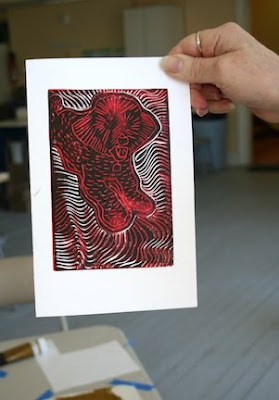We used various methods of printing multiple colors. These photos were all taken on the second day, so I'm sorry to say I don't have any of Connie, who was with us on Saturday.
Ready for the second color © 2010 Karen Lynn Ingalls
Here you can see Carolynne's printing in progress. This was the second color of her print. The first run was of yellow, striking against the lavender color of the paper.
Printing the block © 2010 Karen Lynn Ingalls
Carolynne was making a series of printed cards. This method works beautifully for hand-printed cards.
Carolynne's two color print! © 2010 Karen Lynn Ingalls
This printing process was a reduction cut - with further printings from the same block, which you continue to cut more of. The tricky part is that you can't go back to print more of the first run, once you've cut the block further. You have to really plan in advance.
Hand coloring the block © 2010 Karen Lynn Ingalls
Notice the two blocks? Here you see a second block, using the same design, created from the first, as well as the first block (with its reduction cut), which is being hand colored.
Carolynne's cards and prints © 2010 Karen Lynn Ingalls
Here are some of Carolynne's prints, including several on rice paper, which works beautifully for block printing. Everyone was pleased with the results they got from printing on rice paper.
Donna and her beehives © 2010 Karen Lynn Ingalls
Donna experimented with different ways of combining different blocks or parts of blocks in the same print. She asked herself, what would the hive be like both with and without a background? And what would it be like with bees?
Donna's beehives, with bees © 2010 Karen Lynn Ingalls
Voilà! Bees!
Donna's Isis prints, in copper and gold © 2010 Karen Lynn Ingalls
You can see both the cards Donna created from her Isis block and her Isis and beehive blocks.
Betsy at work, surrounded by blocks, inks, printed gift tags, and carving tools © 2010 Karen Lynn Ingalls
You can see some of the tools we used in the course of creation during the weekend, in the array Betsy is working with at her table.
Betsy with her gingko leaf prints © 2010 Karen Lynn Ingalls
Betsy used several small blocks to create sets of gift tags, using different combinations of colors and different methods of creating multiple colors. Here is one of her wonderful gingko leaves.
Betsy's handmade gift tags, printed with multiple colors on different papers
© 2010 Karen Lynn Ingalls
It's amazing to see the variety of results you can get from one simple block....
One of Betsy's handmade gingko gift tags © 2010 Karen Lynn Ingalls
The subtlety of this hand-applied second color adds a richness to the print. Red and copper make a beautiful combination.
Carolynne and Jane admire one of the prints of Max © 2010 Karen Lynn Ingalls
Jane created a series of prints of Max, her dog, using different combinations of red, black, blue, and gold, with white paper.
Max the Bichon, up close © 2010 Karen Lynn Ingalls
The liveliness of her carving makes for a fun print. We realized, looking at everyone's results, that sometimes when the registration of the second color is a little bit off, it creates some nice special effects with the paper. Happy accidents!
Jane's prints of Max © 2010 Karen Lynn Ingalls
Look at the variety of possibilities! Again, these were all printed from one block.
Admiring Jane's prints of Max © 2010 Karen Lynn Ingalls
This second day of printmaking was a wonderful exploration of possibilities. What a joy! That's what soft block printing is all about, for me.
I'm tentatively scheduling one more Soft Block Printing workshop for the year, in October, for those who would like to learn the process and create cards or prints for the holidays. I'll post the date and time when it is definitely scheduled.









































